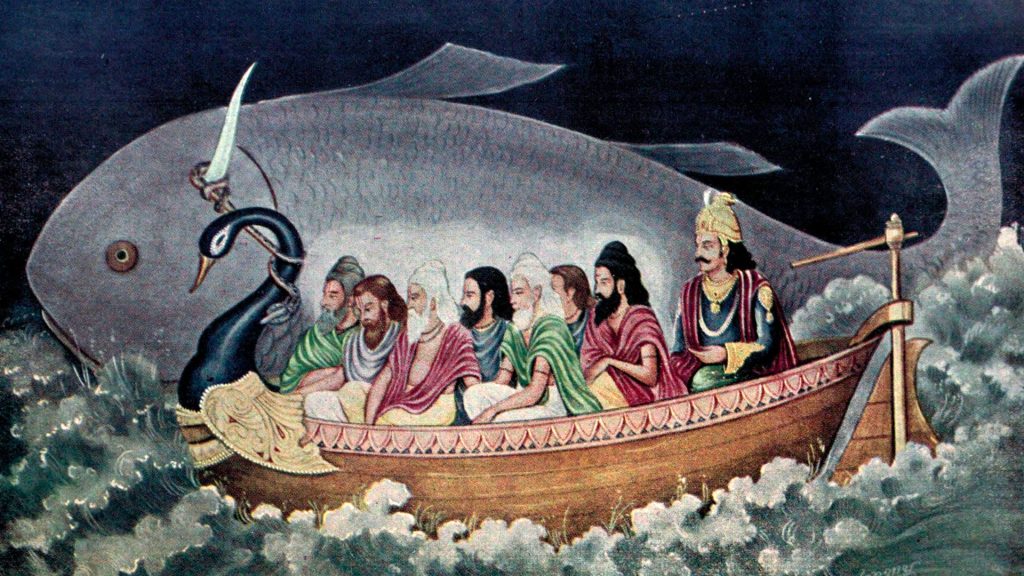Noah’s Ark
The story of Noah’s Ark is a biblical account from the book of Genesis in which God sees that the earth has become corrupt and filled with violence. As a result, God decides to flood the earth to cleanse it of the wickedness. He chooses Noah, a righteous man, to build an ark in which he and his family, as well as two of every kind of animal, will survive the flood. The flood lasts for 40 days and 40 nights, after which the ark comes to rest on the top of a mountain. The story of Noah’s Ark is considered a religious story and is not considered as a historical event by most scientists.

There are several flood myths from different cultures and religions that have similarities to the story of Noah’s Ark. Some examples include:
These flood myths share similarities with the story of Noah’s Ark, such as a god or gods causing a flood to wipe out humanity, and a chosen survivor or survivors who build a boat to escape the flood. However, these are all considered as a religious story and not considered as historical events by most scientists.
Sumerian flood myth
The Sumerian flood myth is found in the Epic of Gilgamesh, which is one of the oldest known works of literature. The epic tells the story of Gilgamesh, the king of Uruk, and his search for immortality. One of the stories included in the epic is the story of a great flood that is sent by the god Enlil to destroy humanity.
In the story, Enlil becomes angry with the noise and overpopulation of humanity, and decides to flood the earth to rid it of the people. However, the god Ea (also known as Enki) warns a man named Utnapishtim about the flood and tells him to build a large boat in which he can survive. Utnapishtim does as he is told and, along with his family and animals, survives the flood.

After the flood, Enlil is angry that some of humanity has survived and sends a bird to check if the waters have receded. The bird returns with a branch in its beak, indicating that the land has re-emerged, and Utnapishtim is able to leave the boat. Enlil then repents his actions and rewards Utnapishtim with immortality.
The Sumerian flood myth, like the story of Noah’s Ark, shares many similarities such as the god’s decision to flood the earth as a means of punishment, the chosen survivor who is warned of the flood, and the use of a boat as a means of survival. But this is considered as a religious story and not considered as historical event by most scientists.
Hindu Flood myth
The Hindu flood myth is found in the Matsya Purana, one of the eighteen major Hindu texts. The story tells of a great flood that occurred during the Satya Yuga (the first of the four yugas, or ages of mankind) that destroyed all life on Earth.
According to the story, the god Vishnu appeared before the king Manu in the form of a small fish and warned him of the coming flood. The fish asked Manu to take him in and protect him, promising that in return, he would help Manu survive the flood. Manu agrees, and as the fish grows larger, he tells Manu to build a boat and gather all the seeds of plants and animals to preserve them.

When the flood comes, Manu and the fish, now in the form of a giant fish, board the boat and sail to safety, while all other life on Earth is destroyed. After the flood, Manu and the fish, now in his original form as Vishnu, repopulate the Earth using the seeds that were saved.
This story shares similarities with the story of Noah’s Ark, such as a god warning a human of an impending flood and providing a means of survival, and the use of a boat to escape the flood and repopulate the earth after the flood. But again this is considered as a religious story and not considered as a historical event by most scientists.
Ancient Greek Flood myth
The ancient Greek flood myth is told in several different versions. One of the most well-known versions is from the poem Metamorphoses, written by the Roman poet Ovid. In this version, the story is about a man named Deucalion and his wife Pyrrha, who are the only survivors of a great flood sent by the gods as punishment for humanity’s wickedness.
In Ovid’s version, Deucalion and Pyrrha seek the advice of the god Prometheus, who tells them to build a large chest and to collect all the bones of their mother (which is interpreted as the Earth) and to throw them behind them. They do this and the bones turn into people, repopulating the earth.

Another version is found in the works of the Greek historian, Hesiod, in his poem “Works and Days”, in which Zeus, the king of the gods, decides to destroy humanity with a flood as punishment for their wickedness and only the son of Prometheus, Deucalion, and his wife Pyrrha, are warned by Prometheus and they build a chest and survive the flood.
Both versions share the idea of a flood sent by the gods as a punishment for humanity’s wickedness and the survival of a select few, in this case, Deucalion and his wife, who are warned by a god and use a chest as a means of survival. But again, these are considered as religious stories and not considered as historical events by most scientists



Comment here